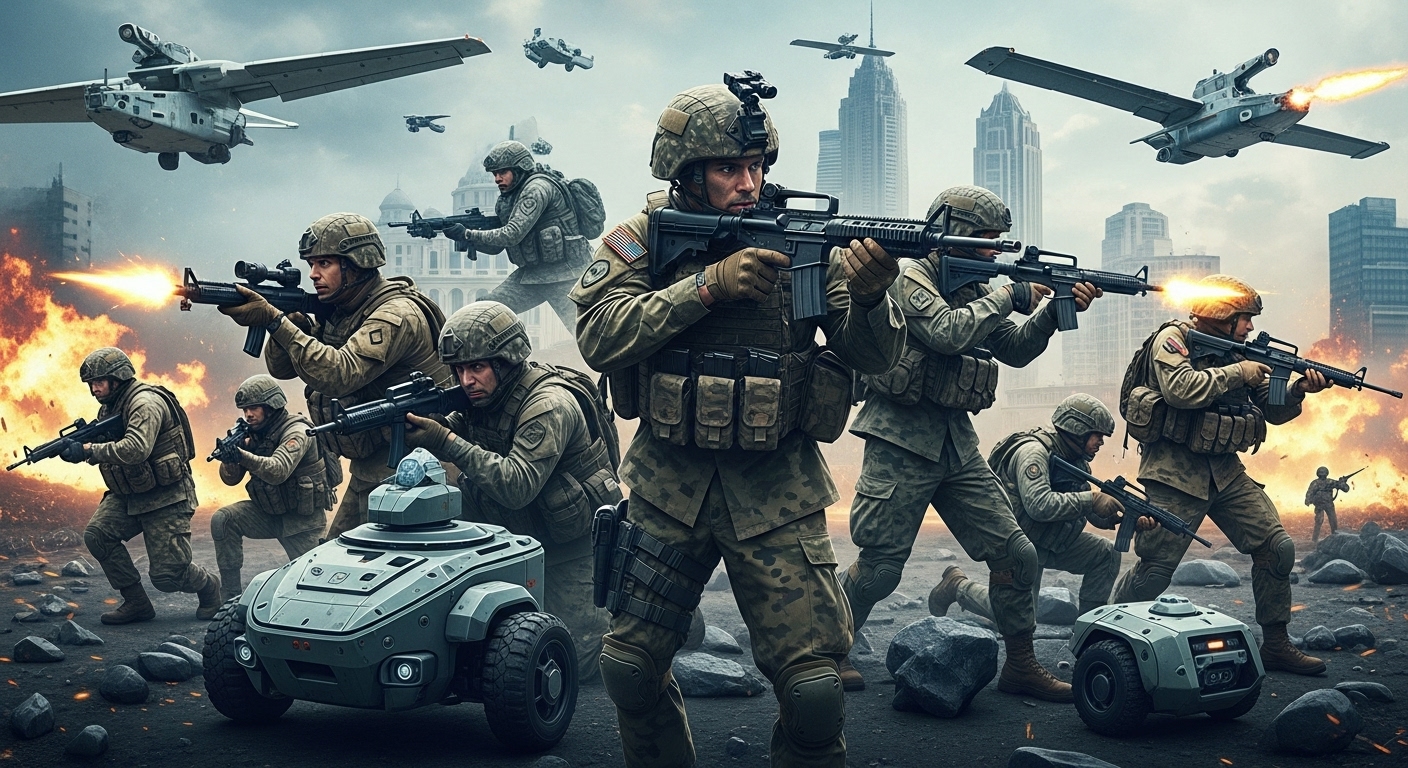“Combat” encapsulates a profound duality in the human experience: the thrilling, stylized spectacle seen in entertainment and the brutal, often devastating reality of armed confrontation. At its core, it’s a direct, physical struggle between opposing forces, constantly redefined by technological innovation, evolving tactics, and a deepening understanding of its human toll.
The Duality of Combat: Controlled Arena vs. Unforgiving Battlefield
The term “combat” carries distinct meanings depending on its context:
- In Entertainment & Sport (Simulated/Controlled Combat): This is the most common encounter with combat for many. It encompasses the meticulously choreographed sequences in action films, the strategic maneuvers in video games (like FPS or fighting games), or the formalized rules of martial arts competitions and combat sports. Here, combat is designed to:
- Thrill and Excite: High stakes, displays of extraordinary skill, and unpredictable outcomes create compelling spectacles.
- Showcase Prowess: Highlight the physical, mental, or strategic capabilities of fictional characters or real-world athletes.
- Advance Narrative: Drive plots forward, create character arcs, and resolve conflicts in a structured way.
- Provide Catharsis: Allow audiences to experience danger and triumph vicariously, in a safe and controlled environment.
- Examples: Mixed Martial Arts (MMA) events like the UFC, professional boxing, wrestling, traditional martial arts demonstrations, and the latest fighting video games such as Guilty Gear Strive on new platforms.
- In Reality (Actual Combat): This refers to real-world armed conflict, self-defense situations, or law enforcement engagements. This type of fighting is characterized by:
- Extreme Danger: The constant, life-threatening risk of injury, severe harm, and fatality.
- Unpredictability and Chaos: Despite meticulous planning, real combat is fluid and chaotic, with unforeseen variables.
- Profound Consequences: Beyond immediate physical injuries, real combat leaves deep, long-term psychological scars (such as Post-Traumatic Stress Disorder – PTSD, depression, anxiety), leads to loss of life, and causes widespread devastation to infrastructure and communities.
- Moral and Ethical Dilemmas: Combatants often face difficult, high-stakes choices with profound ethical implications under extreme pressure.
A Legacy of Adaptation: The Evolution of Fighting
The methods and nature of fighting have evolved constantly alongside human technological and societal development:
- Ancient & Traditional Forms: From rudimentary weapons like clubs and spears to the highly formalized martial arts of ancient civilizations (e.g., Kung Fu, Karate, Muay Thai), emphasizing both combat effectiveness and philosophical discipline.
- Organized Warfare: The rise of organized armies, fortifications, and sophisticated tactics, leading to large-scale battles in ancient and medieval eras. The introduction of the stirrup and heavy cavalry, or the English longbow, fundamentally shifted battlefield dynamics.
- Modern Warfare: The 20th and 21st centuries have seen the advent of air power, armored vehicles, precision-guided munitions, and advanced intelligence gathering. This has transformed the scale, speed, and lethality of conflict.
- The Rise of Combat Sports: The 20th century saw ancient fighting forms formalized into global sports. Boxing and wrestling gained international recognition, followed by the explosion of Mixed Martial Arts (MMA) in the late 20th and early 21st centuries, which synthesizes techniques from various martial arts into thrilling competitive contests.
Trends in Combat in 2025: From AI to Hyper-Realism
As of mid-2025, the world of combat – both real and simulated – is shaped by several key trends:
In Real-World Conflict:
- AI and Autonomous Systems: AI is no longer a buzzword but a crucial component of military operations. Advances in AI facilitate real-time data analysis, predictive maintenance, and increasingly, autonomous decision-making frameworks. Uncrewed Aerial Vehicles (UAVs) and ground vehicles are taking on high-risk missions for reconnaissance, logistics, and even direct combat. The ethical implications of fully autonomous lethal systems, particularly those operating without human oversight, remain a significant global discussion, with some nations actively developing them despite international concerns.
- Robotics and Uncrewed Systems (RAS): The widespread use of military robotics and autonomous systems (RAS) is transforming ground operations. Robots are increasingly taking over dangerous and repetitive tasks, enhancing soldier safety and mission success.
- Cyber Warfare Escalation: Unified cyber defense platforms, integrating threat detection, prevention, and response, are essential. Quantum encryption is being explored to secure sensitive communications against emerging quantum threats. Cyber attacks on critical infrastructure are a constant threat, often preceding or accompanying physical conflict. The cybersecurity landscape is witnessing increasing sophistication and diverse attack vectors from nation-state actors and cybercriminals alike.
- Directed Energy Weapons (DEWs): Militaries are actively deploying laser-based systems for air and missile defense, as well as for countering drones. DEWs offer cost-effective, highly accurate, and virtually endless “ammunition,” becoming a cornerstone of future combat strategies.
- Hypersonic Weapons: These systems deliver unmatched speed and penetration capabilities, making traditional missile defense systems highly challenged. Several nations are expected to develop and deploy hypersonic missiles by 2025, creating a new arms race prioritizing speed and accuracy.
- Advanced Training Simulations: AI-powered adaptive training systems tailor scenarios to individual skill levels. VR-enabled combat simulations offer highly realistic joint-force training environments, allowing personnel to train in immersive, risk-free settings, enhancing situational awareness.
In Entertainment and Sports:
- Hyper-Realistic Choreography: Action films and video games are pushing the boundaries of realism in combat. This involves a seamless blend of practical stunts and cutting-edge CGI, with a focus on believable physics and character reactions. Franchises like John Wick continue to set the standard for intricate and impactful fight sequences.
- AI-Assisted Creativity: AI tools are increasingly used in pre-visualization, special effects, and even in choreographing complex combat sequences for film and game development, allowing for more ambitious and fluid action.
- Immersive Gaming Experiences: FPS and fighting games leverage advanced graphics, haptic feedback, and immersive audio to make combat feel more visceral than ever. VR fighting games offer truly unique first-person combat simulations.
- Growing Popularity of Combat Sports: MMA continues to be a significant force, driving interest in various martial arts. The global combat sports products market is projected for strong growth, fueled by increased media coverage, live broadcasting, and global participation. Hybrid training programs blending multiple martial arts disciplines are also popular.
- Women in Combat Sports: The rise of women in martial arts and combat sports is a major trend, with disciplines like Krav Maga and Brazilian Jiu-Jitsu seeing increased female participation and dedicated women-only classes. This trend is empowering women to take center stage.
The Psychology and Societal Impact
Fighting, whether in a controlled environment or a real-world scenario, has profound psychological implications. Participants in real combat face significant risks of PTSD, depression, and anxiety, impacting their long-term mental health and reintegration into civilian life. The study of combat psychological trauma (CPT) has evolved since World War I’s “shell shock,” with greater emphasis on diagnosis and tailored treatment. Even in training, the discipline required in martial arts can build mental toughness, resilience, and self-confidence.
Societally, fighting in sports provides a controlled outlet for aggression and a powerful spectacle of human achievement. It fosters communities, builds national pride during international competitions, and serves as a testament to the discipline and dedication of athletes. The narrative of overcoming adversity inherent in fighting resonates deeply across cultures.
While the simulated world of entertainment provides a safe space to explore the excitement and drama of conflict, it’s crucial to remember that real-world combat remains a grim and complex reality. Understanding both its allure in fiction and its devastating impact in life is essential for a comprehensive view of this enduring aspect of the human experience.

